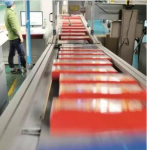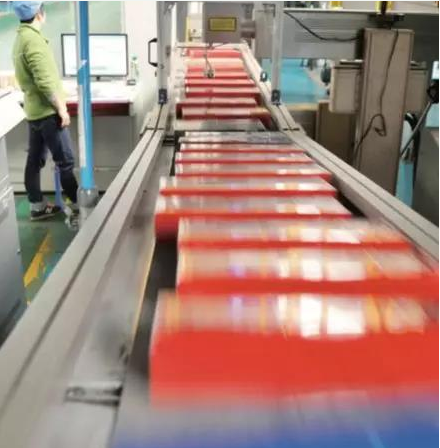
Application of RFID in tobacco logistics
[ad_1]
As an extremely efficient, fast and convenient identification technology, RFID technology has a very wide range of applications in various industries. Baoji Cigarette Factory introduced RFID technology into the tobacco industry logistics system, mainly to improve the efficiency of its tobacco industry production and reduce production costs.

1. Characteristics of logistics system of Baoji Cigarette Factory
After the off-site technological transformation of Baoji Cigarette Factory, it has introduced the most advanced integrated automated logistics system in the country, which has realized the fully automated warehousing and delivery procedures of tobacco leaves, tobacco stems, tobacco auxiliary materials, and finished cigarette products, greatly improving the material in and out. Library efficiency has reduced the error rate, saved labor costs, eliminated safety hazards, and improved the competitiveness of the enterprise. It has become a bright spot of the cigarette factory. According to the classification of functional areas, the logistics elevated warehouse of Baoji Cigarette Factory is divided into three: raw material elevated storehouse, auxiliary material elevated storehouse and finished product elevated storehouse.
The high-rack raw material warehouse is mainly responsible for the entry and exit of tobacco materials such as tobacco leaves, tobacco stalks, and flakes. The specific work flow is as follows: Tobacco leaves, tobacco stalks and flakes are sent from the first floor of the raw material high-rack warehouse to the conveyor automatically by a forklift or a folder. When needed, tobacco stems and flakes are discharged from the warehouse on the first floor of the raw material high-bay warehouse, and the tobacco leaves are discharged from the steel platform on the second floor of the raw material high-bay warehouse. Work.
The auxiliary material high-rack warehouse is mainly responsible for the warehousing of raw and auxiliary materials for cigarettes, such as box skins, box skins, cellophane, cardboard, label paper, etc. The specific work flow is as follows: the raw and auxiliary materials are manually arranged in trays, and then in the auxiliary material high-rack warehouse On the third floor, use a forklift or a folder to send the conveyor into the warehouse automatically. When needed, it will be discharged from the warehouse on the first floor of the auxiliary material overhead warehouse, and then transported to each machine using AGV (automatic guided vehicle).
The finished product high rack warehouse is mainly responsible for the storage and exit of finished cigarettes. The specific work flow is as follows: the finished cigarettes are sent from the first floor of the package workshop to the second floor of the finished product high rack warehouse using a screw conveyor, and then the finished cigarettes are sent through the sorting channel They are sorted and then automatically palletized by ABB robots, and then sent to the shelves by a palletizer. When leaving the warehouse, the stacker will take the finished cigarette box out of the shelf, and the conveyor will send it to the exit port on the first floor of the finished product high-shelf warehouse, where it will be manually loaded and transported away.
2. Application of RFID technology in logistics system
1. General design principles
In the entry and exit operations of the three elevated warehouses, a semi-automated method is adopted, and certain automation technology and machinery are introduced, supplemented by manual operations, to achieve a balance between efficiency and cost.
Deploy electronic tags at the bottom of trays and tobacco stem boxes, and deploy readers at sorting lanes, storage entrances, exits, and carton sealing machines correspondingly, combined with the “Tobacco Industry Cigarette Production and Operation Decision Management System Project (i.e. Project No. 1) )”, which can achieve “one sweep and two sweeps”—the cigarette industry enterprises will paste the barcode issued by the competent department on each cigarette produced, and carry out the outbound scan code and the cigarette commercial enterprise inbound scan code, so that Tobacco authorities can timely grasp and implement effective control of the purchase, production, and sales information of tobacco companies, realize information collection and reasonably connect with the warehouse management system, and transmit data information to the warehouse management system for storage through a combination of wired and wireless methods , Analysis and processing, to achieve the goal of rapid and transparent logistics control.
2. Business process design
In order to carry out effective positioning, the cargo location must be coded first, and the code information is written into the warehouse management system WMS, generally using address coding.
(1) Warehousing business process design
When raw materials and tobacco auxiliary materials are in the warehouse, use a forklift to put tobacco leaves, tobacco stems, tobacco materials, etc. on the tray with electronic labels, and the reader at the entrance of the warehouse will scan the tray electronic labels on the tray with the coded tray to complete For the matching of pallet information and product information, the matching information is transmitted to the warehouse management system. Then the conveyor sends the goods to the aisle stacker, and the stacker performs the storage operation.
When finished cigarettes are put into storage, they must first be sorted through the sorting channel. Install a reader at each sorting lane, scan the electronic barcode on the cigarette box when the cigarette passes through, and quickly identify its type. If the type is met, the cigarette will be pushed into the lane by the side pushing device, and then the ABB robot After palletizing is completed, the conveyor will send the entire pallet of cigarettes to the warehouse, and the reader will scan and record the pallet, and then the conveyor will send it to the stacker station for storage.
The warehouse management system (WMS) determines the storage location of this kind of goods and allocates storage locations based on pre-set storage strategies (such as sorting and random storage), cargo location assignment principles (such as first-in-first-out), cargo inventory status, etc. The information is transmitted to the warehouse control system (WCS), and the warehouse control system drives the conveyor and the lane stacker to complete the warehousing operation.
(2) Outbound business process design
When there is an outbound request, the warehouse management system WMS determines the location of the outbound goods according to the inventory status and outbound rules, and transmits outbound information (such as outbound goods name, quantity, storage location, etc.) to the warehouse control system WCS. The warehouse control system WCS drives the aisle stacker to take out the goods and send them to the outbound station through the conveyor. The RFID reader automatically scans the goods or pallet labels for confirmation and completes the update of the cargo location information. After the error is correct, the shuttle, forklift or AGV trolley Deliver the goods to the designated location. The outbound operation is completed.
After leaving the warehouse, the pallets are manually or automatically sent to the palletizer, the warehouse management system WMS allocates empty spaces to the empty pallet group, and at the same time transmits the information to the warehouse control system WCS, and the warehouse control system WCS drives the conveyor and stacker Send the empty pallet group back to the designated location in the warehouse, and then automatically leave the warehouse for use next time.
After the introduction of RFID technology, the cargo location information can be inquired in real time to provide guidance for other operations. The query mainly includes two aspects:
Cargo query: inventory, distribution, and basic characteristics of a certain kind of goods.
Cargo space query: Cargo space utilization (occupied space, available space, unavailable space), space utilization, etc.
3. Information interaction between RFID and the system
(1) Information interaction with WCS system. After uploading the information of materials or pallets through RFID and sending it to the WCS control system, WCS can issue control instructions to specific logistics equipment through PLC. After the logistics equipment receives the control instructions issued by the WCS system, it can accurately transfer The materials or pallets are transported to the designated target location, and then the final confirmation is made by RFID, and the confirmation information is fed back to WCS to complete the information interaction between RFID and WCS system. In this interaction process, RFID played the role of information collection and initiator, and finally as a confirmer and feedbacker, ending this information interaction.
(2) Information interaction with WMS system. After RFID feeds back the information completed with WCS to WCS, WCS transmits the result to WMS, and the indirect information interaction between RFID and WMS is realized through WCS. WMS summarizes and analyzes this information, and then you can understand inventory information, location information, material classification, and the type and quantity of materials that need to be replenished in real time. This information will directly guide the allocation and purchase of materials, and directly affect production. normal operation. Through this information, the WMS system can issue specific instructions to the WCS system to indirectly guide the operation of the equipment.
Therefore, RFID plays a very important role in the entire WCS and WMS system. It is not only the collector of information, but also the confirmer of the final information. It plays a vital role in the entire flow of information. It can be said that RFID is the core and soul of the tobacco industry’s warehousing and logistics system.
3. Effect evaluation
With the help of RFID technology, electronic tags on tobacco leaves, tobacco auxiliary materials, finished products and work-in-products enable production planning managers to quickly locate them and understand the consumption of tobacco leaves and tobacco raw materials, which will greatly improve the efficiency and quality of production; at the same time; RFID technology can also collect and process product information, helping production personnel easily grasp the operation of the entire production line and the production progress of the product. Furthermore, due to the readable and writable nature of RFID, it can provide a continuously updated real-time data stream, which is complementary to the manufacturing execution system. The information provided by RFID can be used to ensure the correct use of labor, machines, tools and components, thereby achieving paperlessness Production and reduce downtime, and promote the smooth progress of production logistics.
Inventory management is a tedious and complicated task for enterprises, and a large amount of receipt data must be processed every day. After applying RFID technology to the inventory management of manufacturing enterprises, because RFID realizes the automation of data entry, the readers at the entrance and exit of the warehouse will automatically identify the tags when entering and exiting the warehouse, without manual scanning. Based on the information obtained, the management system will automatically update the inventory list. This process greatly simplifies the traditional cargo inspection and storage procedures, eliminating the need for manual inspection, recording, and counting.
The application of RFID technology can automatically and quickly collect a large amount of real-time data generated in the production process, and real-time data processing can be realized with the assistance of a computer network. The application of RFID technology can make it easier for companies to manage production data, improve product quality, reduce and avoid the backlog of semi-finished products, thereby improving corporate production efficiency. Because RFID realizes the automation of data entry, it can realize more information collection and tracking operations, making the location of goods more precise and specific. Therefore, accurate inventory management can be realized with the help of RFID technology.
Furthermore, combining RFID with existing manufacturing information systems such as ERP, MES, etc., can establish a more powerful information chain, and realize the timely delivery of accurate data at accurate time, so that various online measurements and quality control can be carried out. , Improve asset utilization and enhance productivity.
[ad_2]



